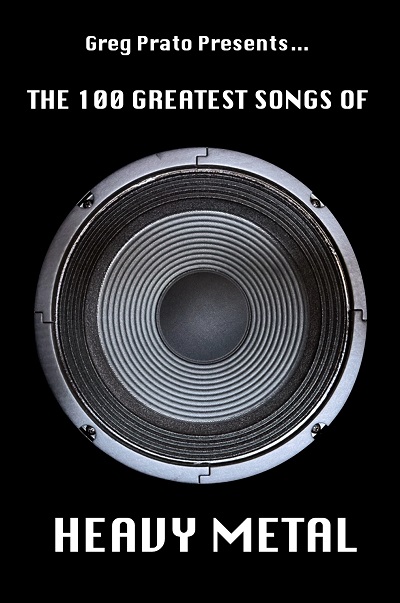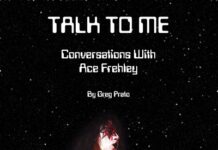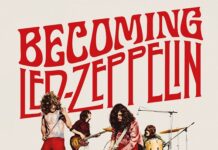By Greg Prato
Did you ever wonder what the 100 greatest songs of heavy metal are? If so, I’m willing to provide some assistance, with the first entry in the Kindle-only “Greg Prato Presents” series, The 100 Greatest Songs of Heavy Metal. The book’s set up? Simple. An analyzation of each selection by yours truly, a quote from the artist themselves or from another respected rocker, and then a link to listen to each tune. Below are several excerpts for you to review, and as a special bonus, I’ve even included a preview of the second “Greg Prato Presents” entry, The 100 Greatest Songs of Punk Rock.
*
Blue Cheer: Summertime Blues
(Vincebus Eruptum, 1968)
The mid-late ‘60s saw many rock guitarists embrace distortion — Dave Davies, Eric Clapton, Jimi Hendrix, etc. But none achieved a sound as fuzzy as Leigh Stevens in Blue Cheer — especially on their hit cover of Eddie Cochran’s “Summertime Blues.” While it admittedly became quite easy to obtain the classic “Blue Cheer guitar sound” shortly thereafter by plugging directly into an Electro-Harmonix Big Muff pedal, Stevens impressively obtained this soon-to-be-sought-after-tone without such a gadget (the Big Muff debuted in either ‘69 or ‘70, while “Summertime Blues” arrived in ‘68).
“I guess we [Rush] had a thing for trios. Blue Cheer was such a cool, trippy name for the time and being the loudest band on Earth made them even cooler. Their rendition of ‘Summertime Blues’ was so unlike Eddie Cochran’s, but it was also the Who’s version that we adored – and they certainly were no slouches when it came to playing loudly, either.” — Alex Lifeson
Dig Deeper: “Magnolia Caboose Babyfinger,” “Out of Focus,” “Doctor Please”
Led Zeppelin: Achilles Last Stand
(Presence, 1976)
Led Zeppelin was thought primarily of as a bluesy hard rock band and/or architects of what became heavy metal…not necessarily contributors to the creation of “prog metal.” But the latter would indeed be a fitting stylistic description of this long-and-winding album opener from their second to last studio set, Presence, which closes in on ten and a half minutes in length — and also, happens to be one of their heaviest tracks.
“The live jams and improvs had their progressive moments, and were certainly incredibly musical…and even some of the lengthier songs like ‘Achilles Last Stand’ and some of the stuff on Physical Graffiti can possibly be pointed to as progressive. But I think Zep were more based in the blues — while true prog music was more based in classical.” — Mike Portnoy
Dig Deeper: “Nobody’s Fault But Mine,” “Carouselambra,” “The Wanton Song”
Def Leppard: Rock of Ages
(Pyromania, 1983)
MTV had already shown that it could help introduce pop acts to a massive audience (Men at Work, Flock of Seagulls, Duran Duran, etc.). But what about a metal band? Def Leppard was the first to make the most out of MTV’s support when it came to their third album overall, Pyromania, and such snazzy videos as “Rock of Ages.” Of course, it didn’t hurt that the song contained a chorus custom made for arenas, nor the enchanted production of Mutt Lange (which would soon become the standard for melodic rock for the remainder of the decade). Gunter, glieben, glauchen, globen — indeed.
It was the ridiculousness of it, which is exactly what the video [‘Rock of Ages’] needed to be. [David Mallet] was like, ‘I want you to walk down this drawbridge holding this sword.’ It’s like, ‘Oh, fuck off. Don’t make me do that!’ Of course, like an idiot, I submitted to his blinked eyes, looking at me like some long-lost dog. David Mallet’s got a great way of manipulating people like that. I was young and dumb and went, ‘OK.’ I look at that now, and I think, ‘What the hell was I thinking’?” — Joe Elliott
Dig Deeper: “Photograph,” “Foolin’,” “Too Late for Love”
Twisted Sister: You Can’t Stop Rock n’ Roll
(You Can’t Stop Rock n’ Roll, 1983)
To many, Twisted Sister are thought of as a glam metal band who were MTV darlings on the strength of two now-classic Animal House-referencing videos (“We’re Not Gonna Take It” and “I Wanna Rock”). But as fans of the band back when they ruled the New York-area bars/clubs have been long-aware, TS were originally a rough and raw metal band (which even bordered on thrash and/or punk at times). Case in point, this classic metal anthem — which also spawned a humorous/imaginative video (in an era where most metal videos were inadvertently hilariously serious).
“Fist pumping in the air, big arena rock, chant-along. Dee’s battle cry to all his rock soldiers and preamble to the mega-hits ‘I Wanna Rock’ and ‘We’re Not Gonna Take It’.” Don Jamieson
“’Under the Blade’ and ‘You Can’t Stop Rock N’ Roll’ was more raw, and then, all of a sudden, we were told to…not ‘bubble gum’ ourselves, but we had to be a little more commercial.” — AJ Pero
Dig Deeper: “Under the Blade,” “I Am (I’m Me),” “Tear It Loose”
David Lee Roth: Shy Boy
(Eat ‘Em And Smile, 1986)
When it was announced that David Lee Roth was departing from Van Halen in 1985, it was understandable if rock fans didn’t expect much from the flamboyant frontman. After all, it was rumored that he was going to make the jump to film, and judging from the style of his then-recent solo EP, Crazy From The Heat, he was pursuing a more Vegas-y/easier-to-digest pop music approach. Then, a funny thing happened — Roth opted to out-Van Halen Van Halen by enlisting a superb supporting cast (guitarist Steve Vai, bassist Billy Sheehan, and drummer Gregg Bissonette) and rocking hard on his solo full-length, Eat ‘Em And Smile. And the album’s most over-the-top tune would later serve as the set-opener on its album’s supporting tour, “Shy Boy,” which was originally recorded by Sheehan’s previous band, Talas (but given a quasi-speed/shred metal makeover here).
“Dave heard the song, liked it, and decided to do it, and I said, ‘Great!’ And he was kind enough to let me keep my publishing on it, which I did, and it was a wonderful success for me as a result. And we did a rearrangement of it — we changed keys of the solo, which is kind of a cool idea. And that was that — he just liked the song and wanted to do it, and I was glad he did.” — Billy Sheehan
Dig Deeper: “Yankee Rose,” “Elephant Gun,” “Bump and Grind”
*
And how about a little sneak peek into my other Kindle book, The 100 Greatest Songs of Punk Rock? You got it!
The Sonics: The Witch
(Here Are The Sonics, 1965)
There was sometimes a fine line between ‘60s garage rock and proto-punk. Case in point, the Sonics and their best-known tune, “The Witch,” from all the way back in ‘65. But what set the Sonics apart from (most of) the rest of the pack at the time was their high-energy performances on record, and that their distorted, three-chord songs were placed right in your face…which a decade later, would become punk’s trademark.
“[Etiquette Records] opened an office in Tacoma, Washington, on Sixth Avenue. We started getting tapes from all over the Northwest. This one lady called, and said, ‘You’ve got to go hear [the Sonics].’ So I went over to this garage. They played this real raucous rock n’ roll song that Gerry Roslie wrote. Remember all the dance songs like ‘Do the Chicken’? I said, ‘That was the best thing I heard all day. I don’t want to date anything here by having it a dance song that’s going to come and go. Re-write the lyrics, and I’ll come back.’ I went back and it was the song ‘The Witch.’ I said, ‘That’s it — we’re going to record that’.” — Buck Ormsby
Dig Deeper: “Strychnine,” “Boss Hoss,” “Psycho”
The 100 Greatest Songs of Heavy Metal is a Kindle-only release which is available for purchase, as well as The 100 Greatest Songs of Punk Rock.




















